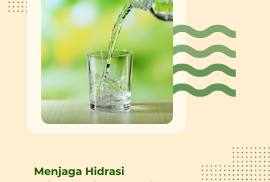Adolescents have an important role in the development of a nation, because healthy adolescents are an investment in the future. One of the health problems that become a burden on adolescents, especially young women, is anemia. Anemia is a condition characterized by a lack of red blood cells in the body, causing fatigue, tiredness, lethargy and impacting the patient’s productivity. In addition, young women who experience anemia are at greater risk of giving birth to low birth weight (LBW) babies and stunting (Sartika et al., 2021). The prevalence of anemia in adolescents in Indonesia is quite high, at 32% (Riskesdas, 2018). Therefore, the prevention and control of anemia in young women is a health problem that is focused on by the government.
Iron deficiency is one of the main causes of anemia. This is caused by the lifestyle of adolescents including inadequate nutritional intake habits (especially sources of iron), the habit of drinking tea and coffee while eating, and lack of physical activity (Kemenkes, 2018). On the other hand, young women need more iron during growth and when blood loss occurs, such as menstruation. Therefore, young women are more at high risk of anemia due to iron deficiency.
Prevention of anemia in adolescents can be done with the following things: 1) increasing the intake of iron-rich foods; 2) iron supplementation by taking blood-added tablets (TTD); 3) increasing consumption of fruits and vegetables as a source of vitamin C; 4) increasing the consumption of animal protein sources; 5) avoiding the consumption of tea and coffee when eating or when consuming iron tablets; and 6) exercising or doing physical activity regularly (Ministry of Health, 2018 and Wouthuyzen et al., 2015). In preventing and overcoming anemia conditions, cooperation from the government and the community is needed. Therefore, teenagers are expected to be able to apply anemia prevention measures in their daily life.
References:
Kementerian Kesehatan RI. 2018. Hasil Riset Kesehatan Dasar (Riskesdas) 2018. Jakarta: Badan Penelitian dan Pengembangan Kesehatan Kementerian RI.
Kementerian Kesehatan RI. 2018. Pedoman Pencegahan dan Penanggulangan Anemia pada Remaja Putri dan Wanita Usia Subur. Jakarta: Badan Penelitian dan Pengembangan Kesehatan Kementerian RI.
Sartika AN, Khoirunnisa M, Meiyetriani E, Ermayani E, Pramesthi IL, Nur Ananda AJ. Prenatal and postnatal determinants of stunting at age 0-11 months: A cross-sectional study in Indonesia. PLoS One. 2021 Jul 14;16(7):e0254662.
Wouthuyzen Bakker, M., & van Assen, S. (2015). Exercise-induced anaemia: a forgotten cause of iron deficiency anaemia in young adults. The British journal of general practice : the journal of the Royal College of General Practitioners, 65(634), 268–269. https://doi.org/10.3399/bjgp15X685069








